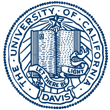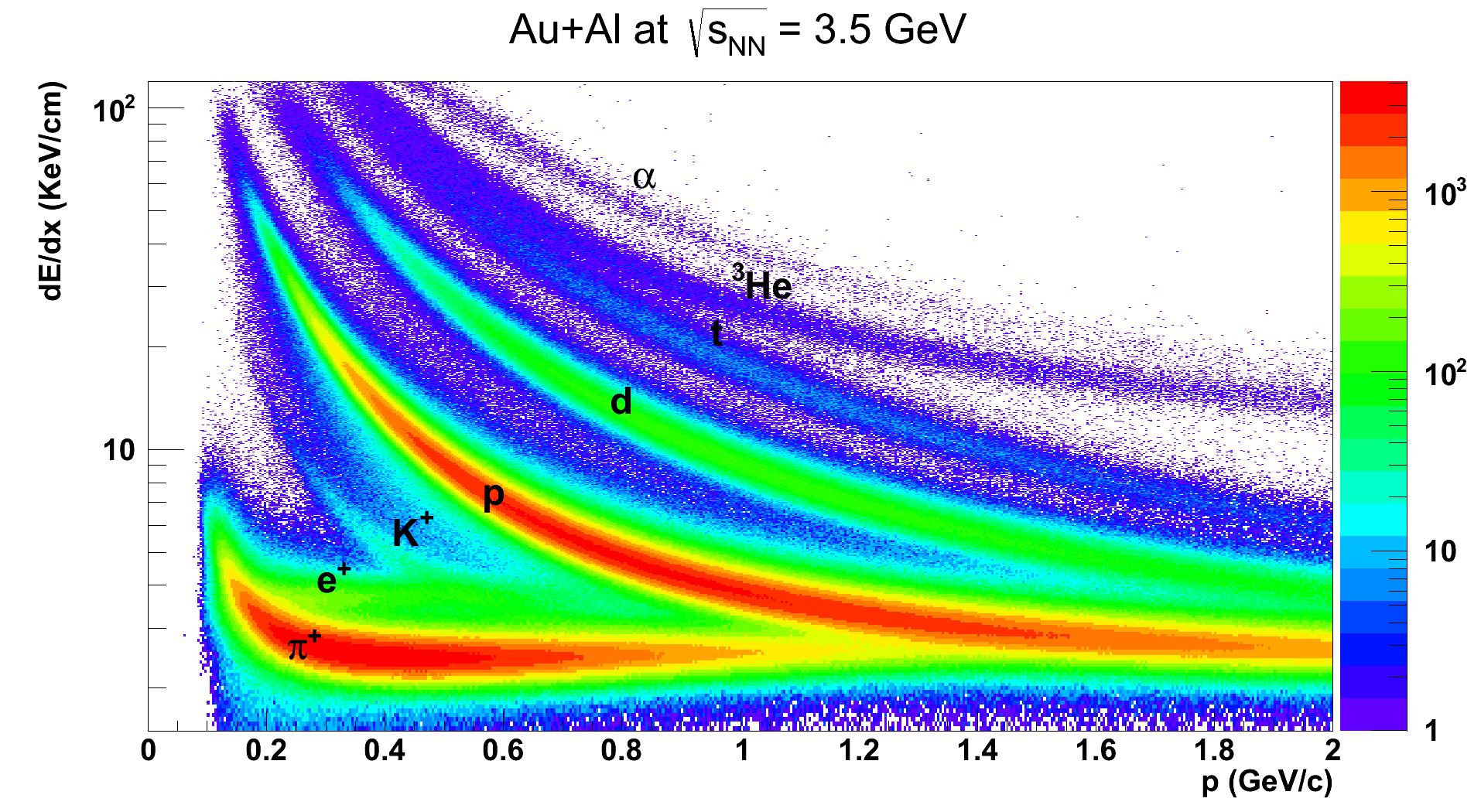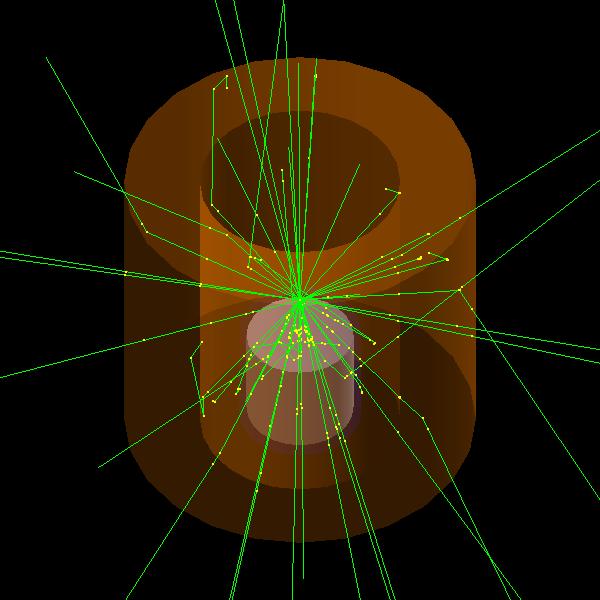
This REU program was funded through NSF PHY-1004848.

Students' names link to their final papers. Advisors' names link to the research group web pages. A few papers remain to be posted.
Condensed Matter, Theory and Experiment
Qudsia Wahab (American River College; advisor Rena Zieve) worked on an experimental model system for avalanches in a granular system. For this experiment the "grains" are steel ball bearings, which are far more regular than those of real materials such as sand or rice. The ball bearings are placed in a tumbler and rotated slowly, and a webcam records any avalanches. At the beginning of the summer a key step of automating the measurements was nearly complete: software to select the webcam images corresponding to the beginning and end of each avalanche, without human intervention. Complete automation is crucial to improving measurement statistics by studying large numbers of avalanches. Qudsia finished testing and adjusting this software and began to acquire avalanche data. She looked particularly at the how inserting a few flexible chains into a pile of grains can change the stability. As recent computational work suggests, in certain cases a very small number of chains can have a significant effect.
One difference between nanomaterials and more everyday substances is that the surface is far more important. The surface-to-volume ratio increases as objects shrink. Since typical atomic separation within solids is a few angstroms, in a sample 1 nm on a side all the atoms are within a layer of the surface. Understanding behavior at surfaces becomes more important with the increasing attention to small length scale materials. Samantha MacIntyre (Shippensburg University; advisor Shirley Chiang) investigated the germanium surface attained through different cleaning procedures. The germanium was first cleaned with argon sputtering, or bombarding with inert argon ions to knock atoms off the surface; this should eliminate many non-germanium contaminants. Afterwards high-temperature annealing of the sample helped to repair any defects in the crystal structure created by the bombardment. Samantha used Scanning Tunneling Microscopy (STM) to visualize the surface. By varying the sputtering energy and the annealing procedure, she found a regime where the surface becomes quite smooth and clean except for the unusual creation of pyramid structures. Samantha presented this work at both a student workshop and professional conferences.
Vincent Gammill (Hendrix College; advisor Richard Scalettar) did Quantum Monte Carlo simulations of bosons in a three-dimensional optical lattice. The optical lattice means that the bosons can be at discrete spatial locations. Vincent used a half-filled lattice, with twice as many sites as particles. Most analytic theory in condensed matter physics assumes infinite samples. This often isn't a bad approximation in real materials, where a cubic centimeter contains about Avogadro's number of atoms. However, computers aren't powerful enough to model so many particles. Vincent dealt with this issue through finite-size scaling, a technique that compares simulations for several lattice sizes and extracts certain results for the infinite limit. Vincent found an insulator-superfluid transition as a function of temperature and quantitatively mapped out the phase boundary.
The circulation around any loop in superfluid helium is quantized; thus swirling fluid only moves at certain speeds. An intriguing consequence is that helium vortices can be extremely long-lived since the fluid flow cannot slow down gradually but only in discrete jumps. Ali Ehlen (Carleton College; advisor Rena Zieve) assembled several cells that will test how a superfluid vortex pinned to a wire can detach from the wire. Previous measurements suggest that the small hole by which helium enters the container plays an important role. Attempts to minimize this by making the hole as small as possible may have backfired, since a small hole leads to large fluid velocities. Ali's cells have much larger entry holes. A nationwide liquid helium crisis and quotas on the university's usage prevented Ali from testing whether her cell design reduced the influence of the entry hole. Instead she worked on computer simulations to understand the behavior of a vortex near a constriction in an otherwise cylindrical cell. This involves numerically solving Laplace's equation in a geometry that lacks enough symmetry for an exact solution. Ali combined a publicly available Laplace solver with her own code to incorporate the specific geometry.
Biological Physics
Michael Warner (Earlham College; advisor Xiangdong Zhu) used optics techniques to study what compounds bind to different strains of flu virus. Non-invasive imaging is carried out on an array of compounds, both before and after exposure to a virus strain. Changes in either the reflectivity or phase shift indicate that an interaction has occurred. The picture below shows the difference between the before and after scans. Sites where reactions took place show up clearly as white spots. Michael found clear distinctions among the binding profiles of different flu strains. The technique has potential as a fast way of identifying what strains are present in a sample. Ultimately understanding the binding, which is the first step a virus takes when invading a cell, may also lead to better techniques for blocking the virus.

Complex Systems
Zachary Meadows (University of Wisconsin, Stevens Point; advisor John Rundle) worked on earthquake modeling software. The "Virtual California" code, and its analogs for other seismically active areas, combines data on the makeup and geometry of faults with both physics-based and ad hoc models of dynamics. Zachary looked into using a mass and spring model to improve the treatment of friction. While the behavior of a small system was promising, showing a buildup of force followed by abrupt collapse, the calculation was too slow for use in the full Virtual California setup. A next step will be to investigate possible improvements to the algorithm such as adaptive mesh refinement and adaptive time steps. These involve varying either the spatial or temporal resolution as needed; for example, time steps can be much larger during the gradual build-up to an rupture event than during the event itself.
General Relativity
Jonah Miller (University of Colorado; advisor Steve Carlip) continued the Causal Dynamical Triangulation project (CDT) that several previous REU students have pursued. Path integral formulations for quantum mechanics are used to calculate the probability of reaching a given final state from a given initial state. Each possible path between the states is considered, with a weight factor depending on its likelihood. (An additional complication is that there is interference between paths.) Extending this approach to gravity would mean considering initial and final configurations of spacetime, and paths by which spacetime could evolve between them. CDT approaches the question numerically, discretizing spacetime into a collection of tetrahedra and applying operations that change the spacetime by altering the tetrahedra. Previous work in Professor Carlip's group had extracted information from simulations with the same initial and final spacetimes. Jonah extended the work to calculations where the initial and final states were both specified but were not identical. He showed that many of the earlier results agree with those of his more general case, and that at least one known sickness of the earlier data disappears once the initial and final states are not identical.
Nuclear and Particle Physics Experiment
Kaitlin Howell (George Mason University; advisor Bob Svoboda) also worked on improving detector performance through Compton suppression. She wrote code in C++ and ROOT to test different detector geometries. Compton scattering dominates the background in the low-energy regime, and Kaitlin's goal was to optimize signal to noise in that energy range. Her initial work shows NaI is a fine material for the Compton suppression portion of the detector, and an annulus of NaI surrounding the rest of the detector is a workable geometry. Further work remains to be done in refining the geometry to achieve the best possible performance.
Particle detectors investigating weakly interacting particles such as neutrinos, cosmic rays, or some dark matter candidates, often rely on a huge system to capture a relatively small number of interactions. For example, the detector may involve hundreds of kilotons of water. One of the problems with these experiments is the background signals they detect from the surroundings. In particular, very small amounts of radioactive impurities in the detector can dominate the background. A useful technique for identifying suitably high-quality materials is through neutron activation analysis (NAA), which can be carried out at McClellan Nuclear Research Center in Sacramento. Neutron bombardment induces radioactive decays to occur at a temporarily higher-than-normal rate, allowing even very low levels of radioactivity to be observed. Joshua Frye (California State University, Sacramento; advisor Bob Svoboda and Mani Tripathi) worked to improve further the sensitivity of NAA. The idea is that some low-energy signal derives from Compton scattering, where a photon deposited only part of its energy in the NAA detector. With complete energy information lacking, the best analysis option is to eliminate these photons from further calculations. Josh used the Geant4 software common in high energy physics to run simulations (tracks shown in the image below) of an actual detector geometry and see the effects of suppressing the Compton scattered photons.

The Relativistic Heavy Ion Collider (RHIC) is designed to accelerate and collide two opposing beams of heavy ions, at present gold. Another mode of operation would be to collide one of the beams with a fixed target, and in fact installation of a fixed gold target will happen soon. In the meantime, researchers already have an accidental source of fixed target collisions to study. The ion beams travel through an aluminum tube, and inevitably some collisions of gold ions with the aluminum walls occur. Rachel Domagalski (American River College; advisors Manuel Calderon de la Barca Sanchez and Daniel Cebra) worked on analyzing these events. A particular goal is to understand the centrality of collisions, or how far the colliding particles are from perfectly on-center with each other. Rachel simulated large numbers of events, which she could then compare to the actual data. She then adjusted the simulation parameters and tried again, searching for the parameters that best matched the experiment. She found an unexpected result, that the sideways flow of particles during the Au-Al collisions increases with Au velocity, as opposed to decreasing with Au velocity for the Au-Au two-beam collisions. Further methods of probing this sideways motion will be investigated.
Paulo Costa (CSU Stanislaus; advisor Mani Tripathi) and Josh Sauza (Pacific Union University) searched for a way to improve purification of the liquid xenon bath used in the Large Underground Xenon (LUX) detector. The experiment attempts to find dark matter through its (infrequent) interaction with xenon atoms. Impurities within the liquid can hide some of these interactions, making an already small signal unmeasurable. For practicality in dealing with a huge vat of xenon, a liquid-phase purification technique would be vastly preferable to the current gas-phase method. Paulo and Josh worked on a method of chipping titanium plates into small pieces with high voltage. The relevant impurities adsorb onto titanium, and small particles have a large surface-to-volume ratio which is favorable for adsorption. Breaking up the titanium in situ provides clean surfaces free from any contaminants. In addition, the voltage sparks that fracture the titanium can also modify the organic molecules which form the most common impurities, in a way that increases the strength of their interaction with the titanium. By the end of the summer Paulo and Josh successfully obtained titanium chips and were studying how the chip sizes depend on the chamber atmosphere and various parameters of the spark setup.
Astrophysics
After the Big Bang, it took several hundred thousand years for matter to condense into neutral atoms. The universe before this recombination is invisible to even the most powerful telescopes, since light itself scattered frequently off the high density of charged particles (electrons and nuclei). Eventually there was some reionization, but by then the universe had expanded so much that the density of charged particles was much reduced and caused only a partial opacity. The cosmic microwave background radiation is exactly the signal from those photons that last scattered at the time of the original recombination. The variations with direction connect to details of the Big Bang itself and later occurrences such as galaxy formation. John Zanazzi (Northern Arizona University; advisor Lloyd Knox) studied what further information can be extracted as the resolution of cosmic microwave background radiation measurements improves. He looked into ways of numerically extracting high-order multipoles from the data.
Galaxies form various large-scale structures. Galaxy clusters include a large number of galaxies in proximity (where of course the distances are still very large compared to on any terrestrial scale). In galaxy filaments, the galaxies have much greater extent along one direction, so that many galaxies lie roughly along a line. Theories of how such filaments could form may give predictions as to the orientation of galaxies within or near the filaments. Emily Finney (Scripps College; advisor David Wittman) searched the Deep Lens Survey data for any indication of a preferential alignment of galaxies. She identified likely filaments through the positions of clusters with small separation from each other, then looked for galaxy alignment along the filament. So far she has found no statistically significant orientation patterns.